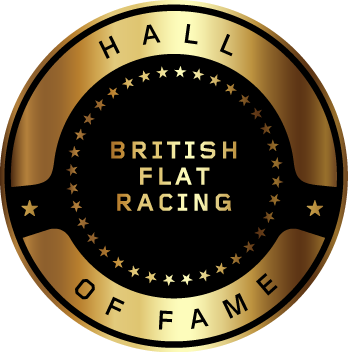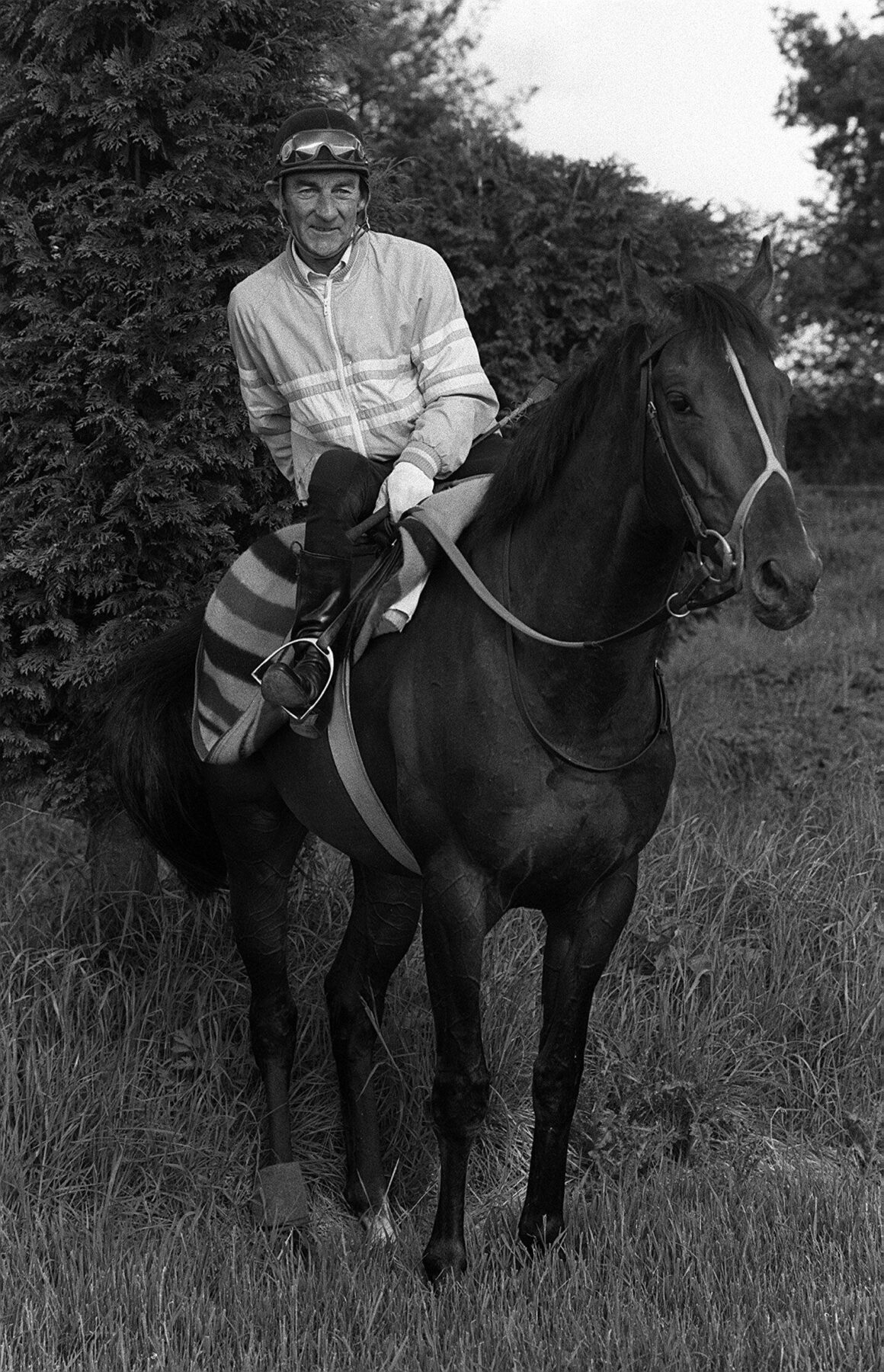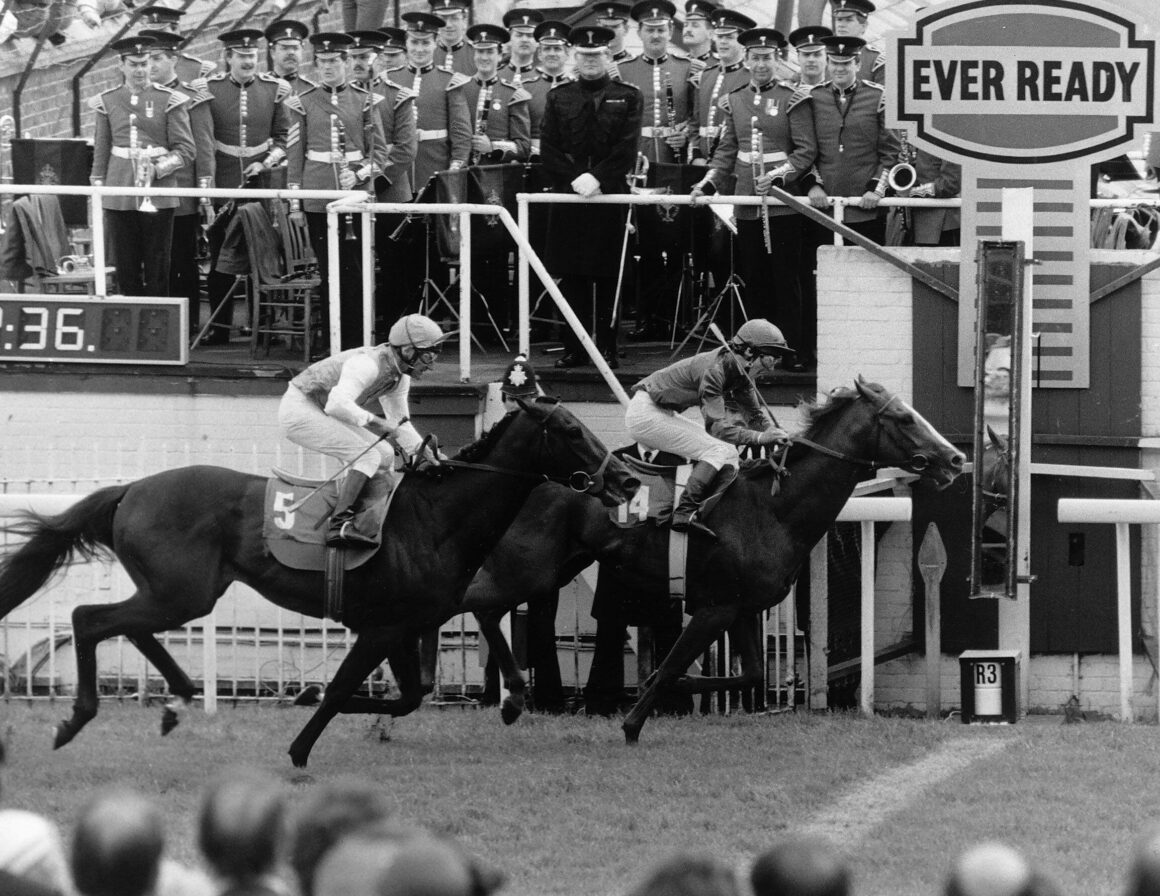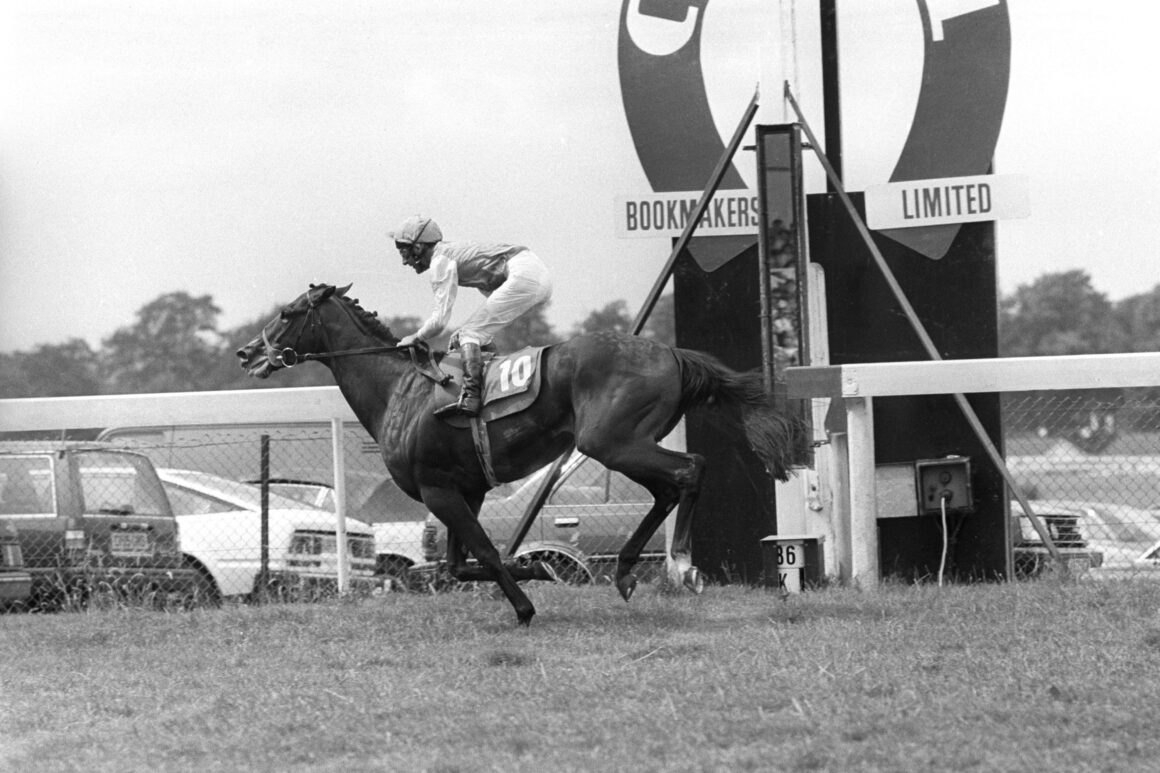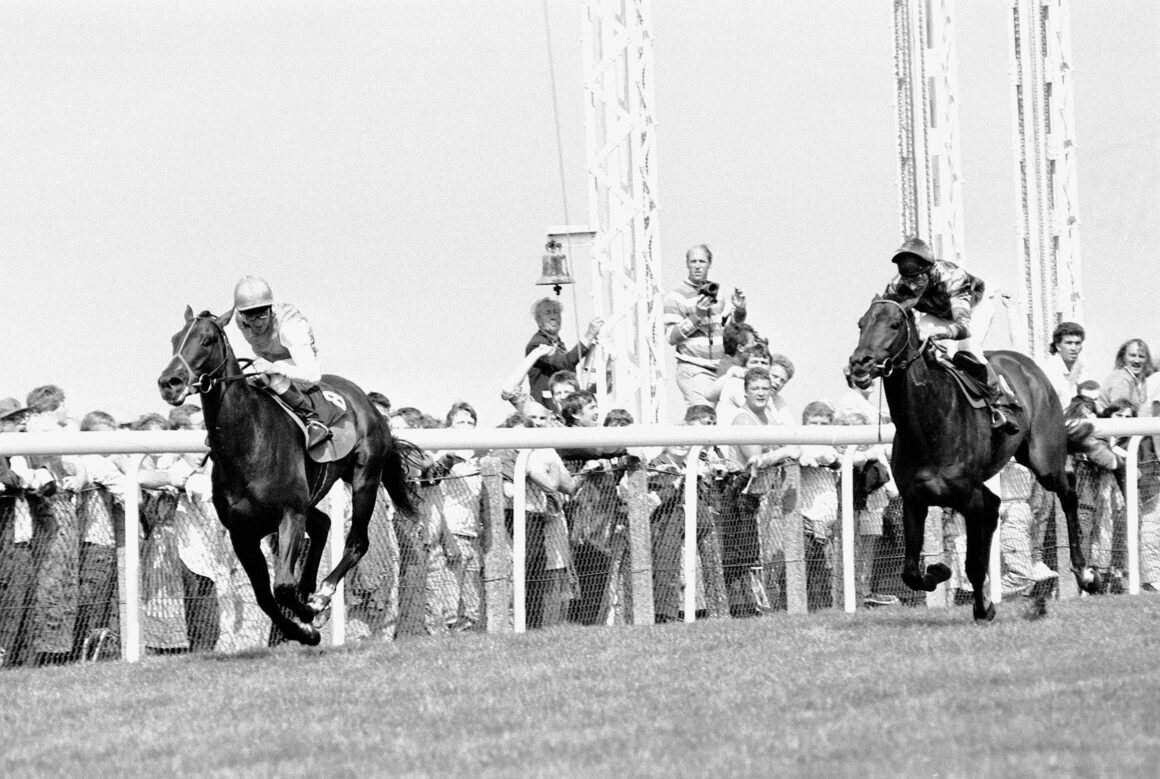Dancing Brave
Dancing Brave carried almost all before him during his captivating career and his brilliance is recognised through his induction into the QIPCO British Champions Series Hall of Fame.
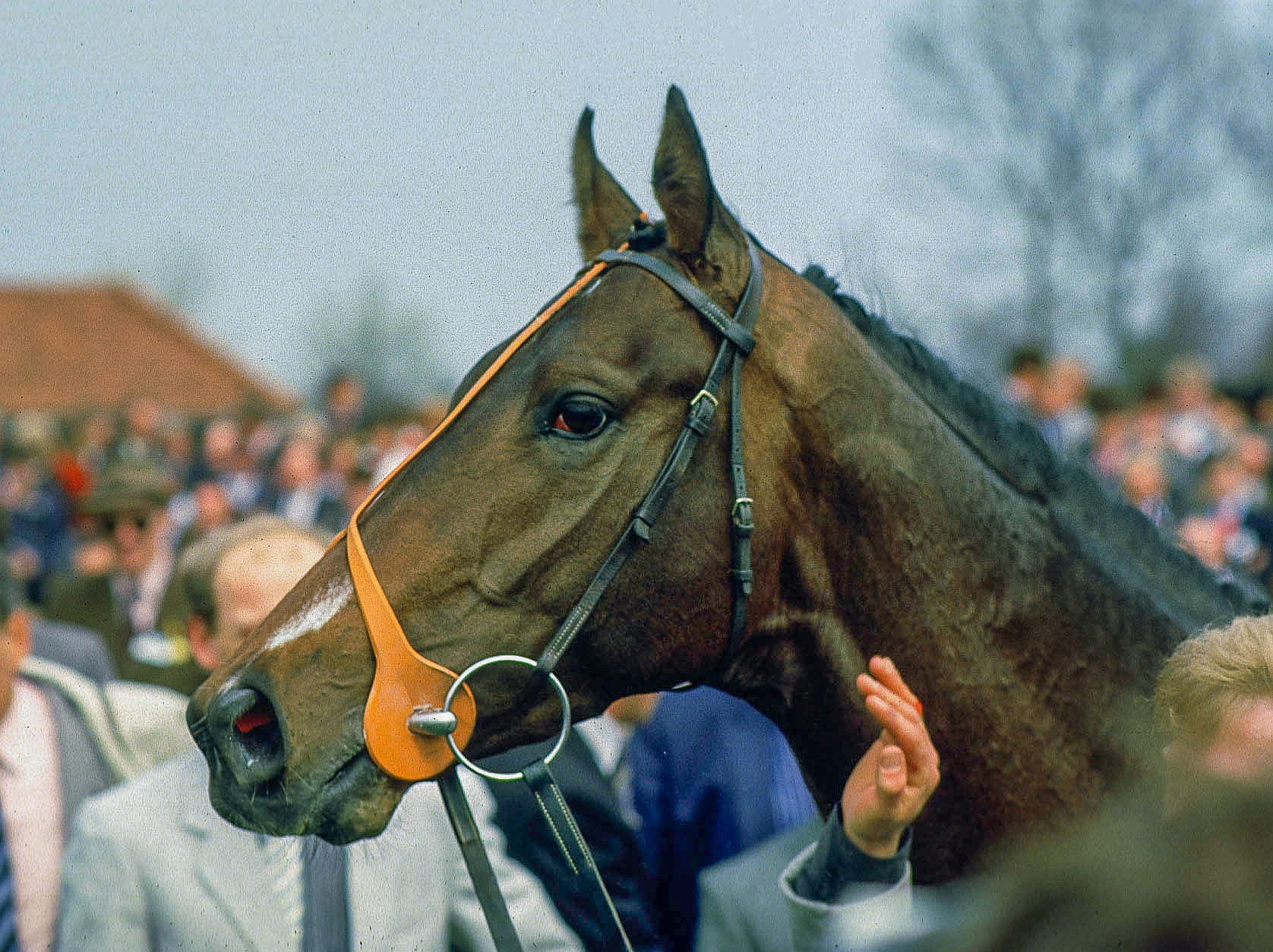
Dancing Brave after winning at the Craven Stakes at Newmarket.
The bay colt, owned by the late Prince Khalid Abdullah and trained by Guy Harwood, dazzled in 1986 when his six victories included the 2000 Guineas, Eclipse, King George VI and Queen Elizabeth Stakes and an epic renewal of the Prix de l’Arc de Triomphe. He was also an unlucky loser in The Derby, although the manner of his defeat only added to his legend.
His versatility and turn of foot, not to mention constitution, made him stand out from the crowd. The only horse rated superior to him since the International Classifications were first published, in 1977, has been the mighty Frankel, who was also owned by Prince Khalid under his Juddmonte Farms banner.
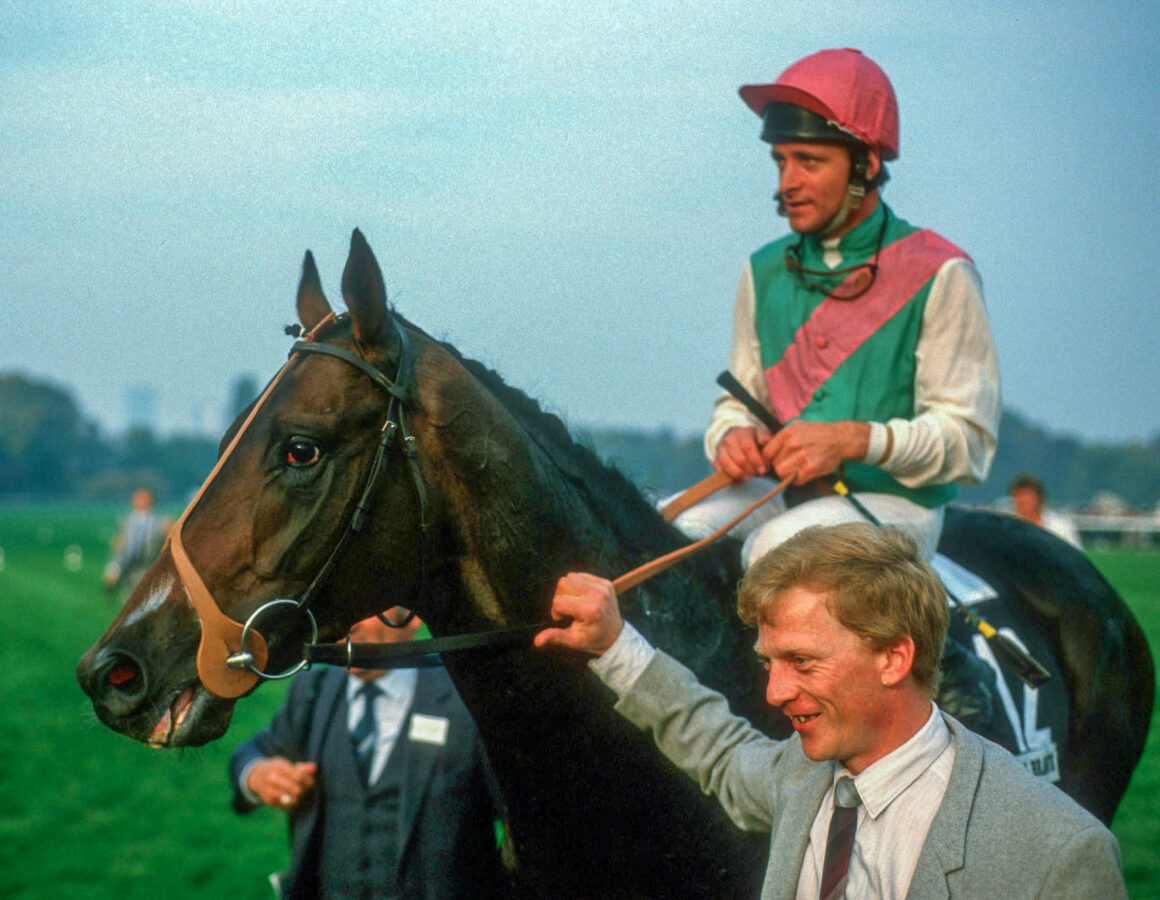
Dancing Brave with Pat Eddery after winning the Prix de l’Arc de Triomphe
His versatility and turn of foot, not to mention constitution, made him stand out from the crowd. The only horse rated superior to him since the International Classifications were first published, in 1977, has been the mighty Frankel, who was also owned by Prince Khalid under his Juddmonte Farms banner.
Frankel was a homebred trained by Sir Henry Cecil in Newmarket, whereas Dancing Brave was a $200,000 purchase at the 1984 Fasig-Tipton July sales in America, sent to Harwood’s yard in Pulborough, Sussex. It was renowned bloodstock agent James Delahooke who bought him on Prince Khalid’s behalf after being struck by his movement and balance.
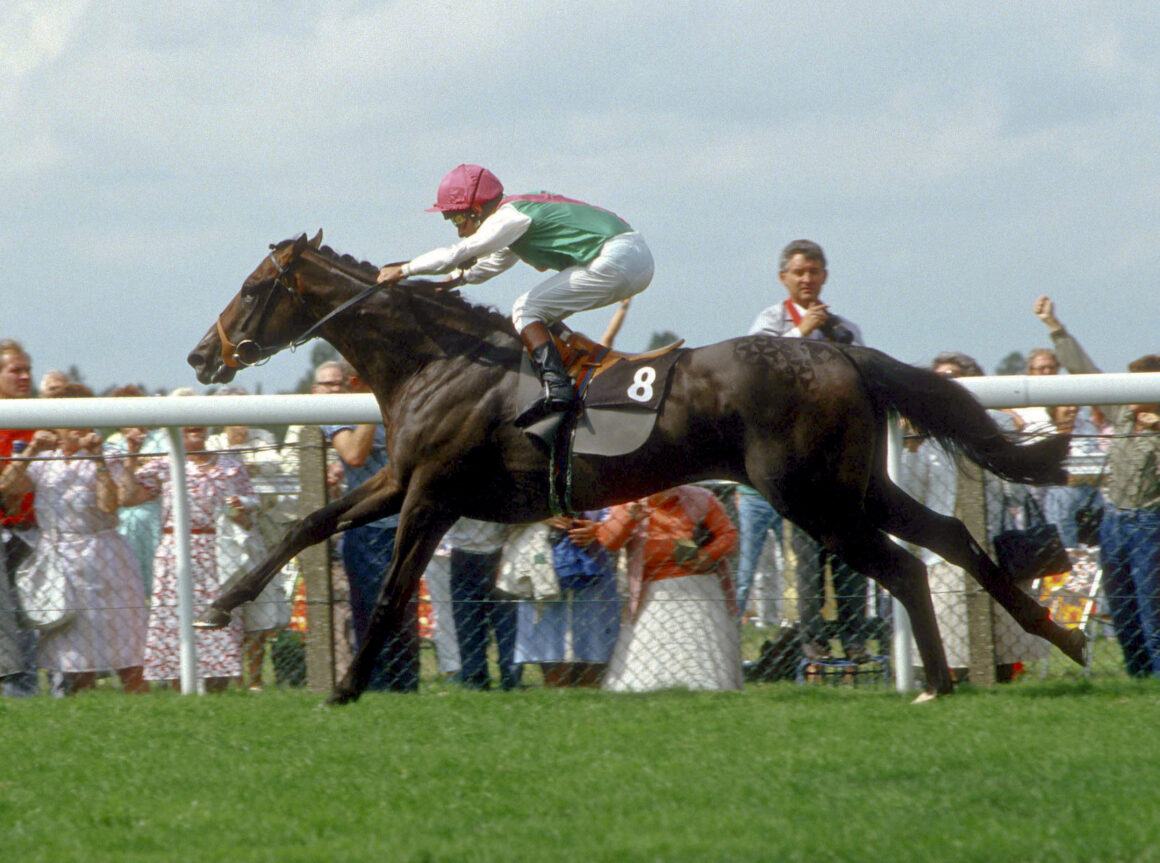
Dancing Brave during the 1986 King George VI and Queen Elizabeth Stakes
He believed the son of smart French performer Lyphard, whose dam Navajo Princess won 16 races in America, would have fetched much more but for minor faults which included a “parrot mouth”, where the upper lip of a horse hangs forward and down ahead of the lower lip.
Harwood gave his new recruit time to find his feet and Royal Ascot had already come and gone by the time he started to catch the eye. “He was a late May foal and he went down to the bottom yard with the backward yearlings,” the trainer explained. “One day in July, I was watching the third lot from the bottom yard and said to my lad Chris Read, ‘who’s that horse Chris?’, he said ‘that’s Dancing Brave’, and I said ‘drop him off at the top yard on the way out’. That’s when he first came into my life.”
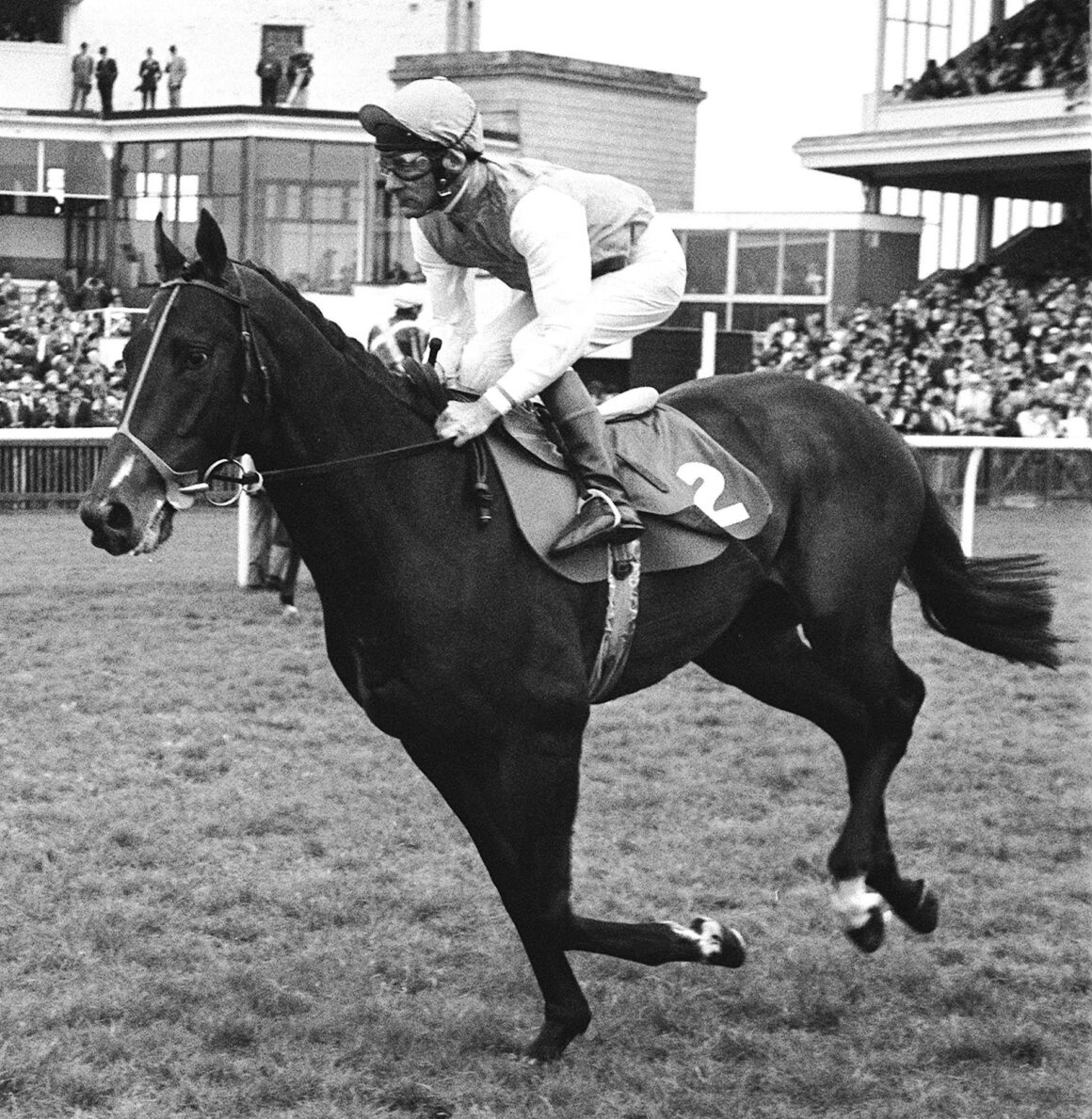
Dancing Brave brushed aside three rivals in the Dorking Stakes over a mile at Sandown Park on his debut in 1985, and was then easy on the eye when following up in the Soham House Stakes over the same trip at Newmarket. He went into winter quarters as a live contender for the 2000 Guineas, despite being untested in deeper waters and officially rated some way off the top two-year-olds.
Those backing him at fancy ante-post prices were on good terms with themselves when Dancing Brave comfortably won the Craven Stakes back at Newmarket on his return, and they also had few anxious moments in the Guineas itself. In a steadily-run renewal, he settled beautifully in a prominent position and burst three lengths clear of Green Desert when invited to put his stamp on proceedings. “I’ve never been down the hill so fast,” said Walter Swinburn, the rider of the runner-up. “I was motoring, and then this thing [Dancing Brave] came flying by.”
The Derby was over half a mile further and was going to require staying power, but it wasn’t lack of stamina that betrayed the 2/1 favourite. Jockey Greville Starkey settled him towards the back of the 17-runner field and with just three furlongs to run was still much nearer last than first, perhaps as much as 15 lengths off the lead. Dancing Brave showed astonishing pace to pass 14 of his rivals from widest of all – he clocked a breathtaking 10.2sec for the penultimate furlong – but the Michael Stoute-trained Shahrastani, the winner of two key trials and the second favourite at 11/2, had been given a textbook ride and was a fast-diminishing half-a-length ahead at the line.
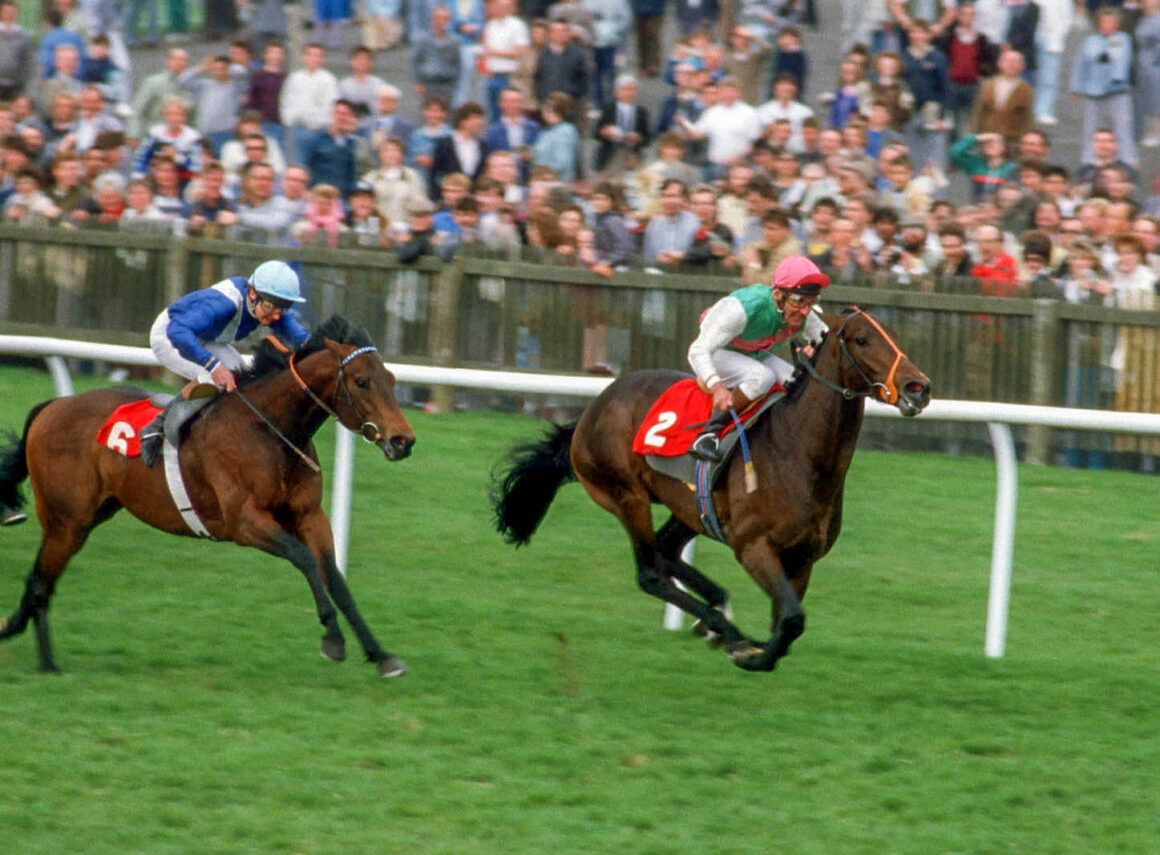
1986 2000 Guineas winner Dancing Brave & jockey Greville Starkey
Starkey, 46, was heavily criticised in the aftermath and there was an overwhelming sense that the best horse had finished second. The rider suggested Dancing Brave had effectively fallen asleep; and that as a consequence, he had not immediately got the message when asked to go forward. Following the race, Prince Khalid agreed to sell half of Dancing Brave to Sheikh Mohammed, with the horse to stand at Dalham Hall Stud at the end of his racing career.
Any fears that Dancing Brave’s Epsom exploits might have left a mark were extinguished the following month when he won two of the year’s biggest Group 1 prizes in quick succession. He zoomed clear of a deep field over a mile and a quarter in the Eclipse Stakes at Sandown Park and then won a ferociously run King George VI and Queen Elizabeth Stakes at Ascot after hitting the front with jockey Pat Eddery on board, replacing an injured Starkey, sitting motionless and looking over his shoulder for dangers. Shahrastani went off favourite that day, having followed up his Derby success with an eight-length win in the Irish equivalent, but faded to be fourth.

The Arc was now on Dancing Brave’s horizon but before heading to Longchamp on the first Sunday in October he had a “home match” at Goodwood, running away with the Select Stakes in a course–record time. Harwood was delighted with Dancing Brave’s preparation for France’s premier race but his star performer was going to have to be better than ever to prevail from an unfavourable wide draw with Bering (winner of the French Derby in a record time), Shahrastani and Acatenango (German Derby winner) among the 14 opponents waiting for him in a stellar line-up. Between them, the runners had won 18 Group 1 races.
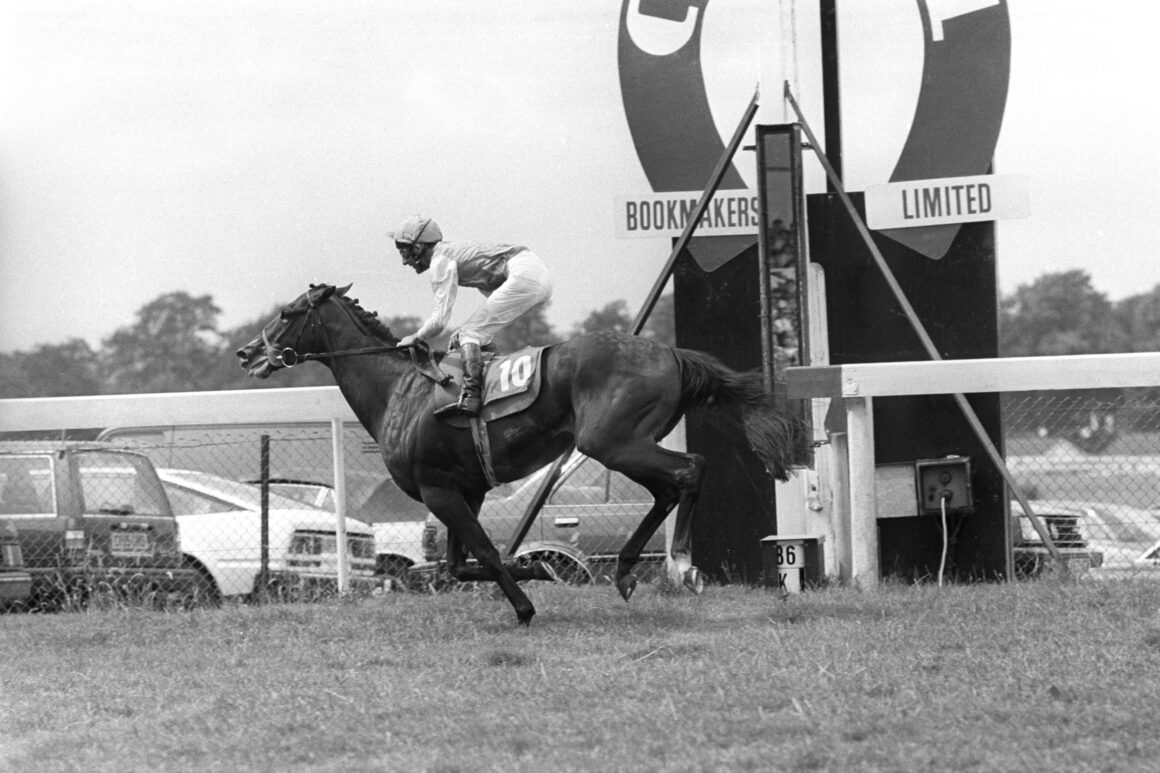
A furlong and a half out, Dancing Brave still had 11 rivals in front of him with Bering having seemingly got first run. But Eddery, chosen ahead of Starkey for the race, had been counting to dix and when he finally unleashed Dancing Brave, he took off and surged to the front to win going away by a length and a half. The winning time was a record 2min 27.7sec. Eddery described him as “electrifying” and a “once in a lifetime ride”, while Harwood said years later: “The most confident I have been was ahead of the Arc. There are just times you know they are 110 per cent.”
Dancing Brave ended his racing career a month later with a below-par fourth in the $2 million Breeders’ Cup Turf at Santa Anita. He had endured a demanding campaign which included sustaining an eye injury in what was to be his final race and while it was a subdued exit, memories of his previous exhilarating exhibitions remained vivid.
The esteem in which Dancing Brave was held was reflected by his stud fee of £120,000. He was known to often pass on his ‘parrot mouth’ to his sons and daughters, but very few of his offspring shared anything like his brilliance – although he did father a Derby winner in Commander In Chief, plus an Irish Oaks heroine in Wemyss Bight. Following some fertility problems, he was eventually exported in 1991 to continue his stud career in Japan. Dancing Brave died of a heart attack in the summer of 1999, aged 16.
Those closest to him said he was a placid and amiable horse at home, saving his power and ruthlessness for the racecourse. He becomes the sixth equine member of the QIPCO British Champions Series Hall of Fame, following in the footsteps of Frankel, Brigadier Gerard, Mill Reef, Nijinsky and Dayjur.

